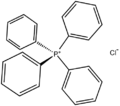Counterion
Counterion refers to the ion that accompanies an ionic species in order to maintain electric neutrality. In chemistry, counterions are often discussed in the context of salts and ionic compounds, where they balance the charge of the other ion in the compound. The concept is also crucial in biochemistry, particularly in the study of biomolecules and cell membranes, where counterions play significant roles in the structure and function of proteins and nucleic acids.
Overview[edit]
In an ionic compound, the total positive charge must equal the total negative charge, ensuring the compound is electrically neutral. The ion that is not the primary subject of discussion but serves to balance the charge is known as the counterion. For example, in sodium chloride (NaCl), sodium (Na+) acts as the counterion to chloride (Cl−), and vice versa. Counterions can significantly influence the physical and chemical properties of ionic compounds, including their solubility, melting point, and reactivity.
Role in Biochemistry[edit]
In biochemistry, counterions are essential for the stability and function of macromolecules. For proteins, counterions can affect their folding, stability, and interaction with other molecules. In the case of nucleic acids like DNA and RNA, counterions neutralize the negative charges of the phosphate backbone, affecting their structure and interactions with proteins.
Types of Counterions[edit]
Counterions can be categorized into two main types based on their charge: cations and anions. Cations are positively charged ions, while anions are negatively charged. The choice of counterion can affect the properties of the ionic compound. For example, a bulky counterion might increase the solubility of a compound in organic solvents, while a smaller counterion might favor solubility in water.
Applications[edit]
Counterions find applications in various fields, including pharmaceuticals, where they are used to form salts of drugs to modify their solubility and absorption characteristics. In polymer science, counterions can influence the behavior of polyelectrolytes, which are polymers that carry multiple charged groups.
Environmental and Health Considerations[edit]
The choice of counterion can also have environmental and health implications. For instance, certain counterions may be more toxic or less biodegradable than others, affecting the overall safety and environmental impact of the compound.

This article is a biochemistry stub. You can help WikiMD by expanding it!
-
Lithium tetrakis(pentafluorophenyl)borate
-
Tetraphenylborate
-
Hexafluorophosphate
-
Tetrafluoroborate ion
-
Bis(triphenylphosphine)iminium chloride
-
Tetraphenylphosphonium chloride
-
Tetrabutylammonium bromide
-
Bis(12-crown-4)lithium cation
Ad. Transform your life with W8MD's Budget GLP-1 injections from $75


W8MD offers a medical weight loss program to lose weight in Philadelphia. Our physician-supervised medical weight loss provides:
- Weight loss injections in NYC (generic and brand names):
- Zepbound / Mounjaro, Wegovy / Ozempic, Saxenda
- Most insurances accepted or discounted self-pay rates. We will obtain insurance prior authorizations if needed.
- Generic GLP1 weight loss injections from $75 for the starting dose.
- Also offer prescription weight loss medications including Phentermine, Qsymia, Diethylpropion, Contrave etc.
NYC weight loss doctor appointmentsNYC weight loss doctor appointments
Start your NYC weight loss journey today at our NYC medical weight loss and Philadelphia medical weight loss clinics.
- Call 718-946-5500 to lose weight in NYC or for medical weight loss in Philadelphia 215-676-2334.
- Tags:NYC medical weight loss, Philadelphia lose weight Zepbound NYC, Budget GLP1 weight loss injections, Wegovy Philadelphia, Wegovy NYC, Philadelphia medical weight loss, Brookly weight loss and Wegovy NYC
|
WikiMD's Wellness Encyclopedia |
| Let Food Be Thy Medicine Medicine Thy Food - Hippocrates |
Medical Disclaimer: WikiMD is not a substitute for professional medical advice. The information on WikiMD is provided as an information resource only, may be incorrect, outdated or misleading, and is not to be used or relied on for any diagnostic or treatment purposes. Please consult your health care provider before making any healthcare decisions or for guidance about a specific medical condition. WikiMD expressly disclaims responsibility, and shall have no liability, for any damages, loss, injury, or liability whatsoever suffered as a result of your reliance on the information contained in this site. By visiting this site you agree to the foregoing terms and conditions, which may from time to time be changed or supplemented by WikiMD. If you do not agree to the foregoing terms and conditions, you should not enter or use this site. See full disclaimer.
Credits:Most images are courtesy of Wikimedia commons, and templates, categories Wikipedia, licensed under CC BY SA or similar.
Translate this page: - East Asian
中文,
日本,
한국어,
South Asian
हिन्दी,
தமிழ்,
తెలుగు,
Urdu,
ಕನ್ನಡ,
Southeast Asian
Indonesian,
Vietnamese,
Thai,
မြန်မာဘာသာ,
বাংলা
European
español,
Deutsch,
français,
Greek,
português do Brasil,
polski,
română,
русский,
Nederlands,
norsk,
svenska,
suomi,
Italian
Middle Eastern & African
عربى,
Turkish,
Persian,
Hebrew,
Afrikaans,
isiZulu,
Kiswahili,
Other
Bulgarian,
Hungarian,
Czech,
Swedish,
മലയാളം,
मराठी,
ਪੰਜਾਬੀ,
ગુજરાતી,
Portuguese,
Ukrainian








